El Niño on a Warming Planet
Air Date: Week of January 22, 2016
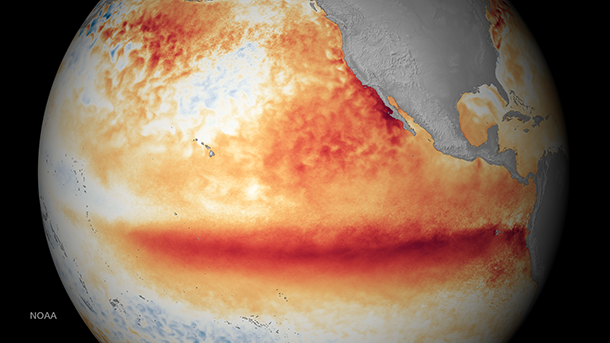
El Niño weather pattern in the Pacific (Photo: NOAA, CC BY-2.0)
A powerful el Niño weather system born of heat in the Pacific is bringing heavy rains, ice and snow to parts of the US and typhoons to Asia. With record rainfall and flooding along the Mississippi River, Roy Buol, the mayor of Dubuque, Iowa describes what his city is doing to cope with the extreme weather. Host Steve Curwood and climate scientist Kevin Trenberth of the National Center for Atmospheric Research discuss the relationship between severe weather associated with El Niño and global warming and what we might expect as average world temperatures continue to rise.
Transcript
CURWOOD: It’s Living on Earth, I’m Steve Curwood. The heavy rains associated with El Niño this winter brought record floods to the Mississippi River basin. Roy Buol is the Mayor of Dubuque, Iowa, along the Mississippi. His city didn’t experience the devastation of some other cities nearby, but all this rain has him concerned.
BUOL: It is very very unusual weather that we have been experiencing, you know the amount of rain, the intensity, the amount of flooding that’s occurring up and down the river. This obviously is one of the bigger events that collectively we’ve seen.
CURWOOD: Mayor Buol says that many of the residents in his town are connecting the dots between these storms and global warming, and the city is taking steps to become more resilient in the face of increasingly wild weather.
BUOL: As flooding becomes more severe and unpredictable we realized that we needed to protect our residents and our infrastructure by making some aggressive changes in our city. Now the city of Dubuque is working with the Army Corps of Engineers to assess the strength of our floodwall or levy, which has protected the city from the Mississippi since 1965. We are now reviewing overtopping and failure scenarios and exploring how we can mitigate flooding if the floodwall were to fail due to climate change results. And the historic flooding levels that the Mississippi River potentially could have in the city Dubuque.
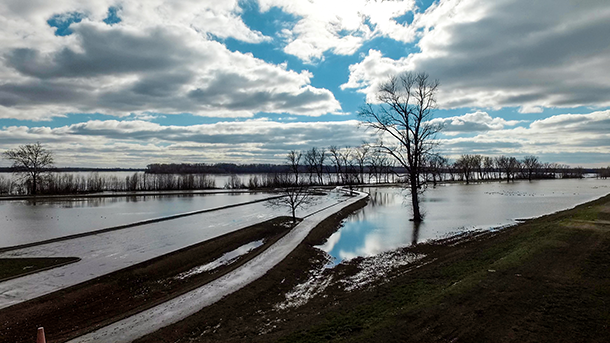
Mississippi flooding outside of St. Louis (Photo: N, Flickr CC BY-NC-ND 2.0)
CURWOOD: Dubuque is part of the Mississippi River Cities and Towns Initiative, which seeks to increase collaboration among river communities on ways to adapt to climate change. Mayor Buol joined mayors at the Paris climate summit in December to talk with leaders from other river basins around the world. They reached an agreement to work together.
BUOL: And we actually got 15 basins to sign on to that agreement to work together to create resiliency and some best practices, knowing full well that the Mississippi River is the food basket of the world, and that population increases over the next 20 years when we hit 9.5 billion people, those people are going to have to be fed. So we’re trying to work with them to create some global cooperation around water and food security.
CURWOOD: That’s Dubuque Mayor Roy Buol.
Whether it’s heavy ice and snow or torrential rains, the extreme weather events around the world linked to El Niño don’t always come out of the blue. Scientists have been warning of the possibility of a strong El Niño since 2014, and such warnings, if heeded, can help communities cope. We often turn to distinguished scientist Kevin Trenberth of National Center for Atmospheric Research to talk about El Niño’s impacts around the world. Kevin, welcome back to Living on Earth.
TRENBERTH: Thanks for having me.
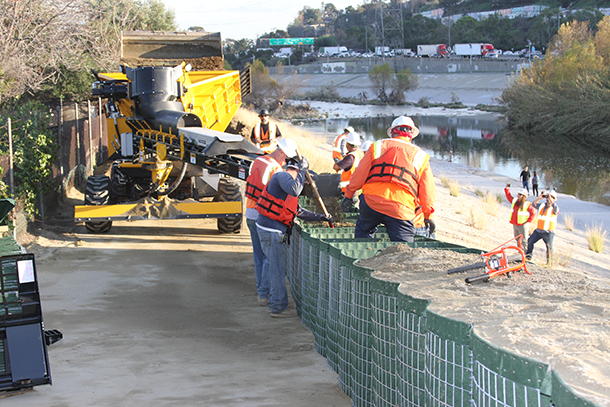
The Army Corps of Engineers installs a barrier along the Los Angeles River to prepare for this winter’s El Niño. (Photo: US Army Corps of Engineers Public Affairs, CC BY-ND 2.0)
CURWOOD: First, just remind us of the El Niño phenomenon. People use this phrase all the time but what exactly is it?
TRENBERTH: It really refers to a warming of the central and eastern Pacific. Prior to El Niño there is a buildup of heat in the ocean. The ocean heat content and higher sea levels in the western tropical Pacific and then during El Niño, that heat spreads across the Pacific, it comes back into the atmosphere mainly in the form of, well, cooling the ocean but evaporative cooling of the ocean and then moistening of the atmosphere and then that moisture gets caught up in weather systems and invigorates weather systems around the world and especially in the Pacific and that gives back the heat to the atmosphere that went into evaporating the atmosphere in the first place. And so there is a mini global warming in the latter stages of an El Niño event and so this El Niño has also contributed to 2015 being the warmest year on record, actually by far.
CURWOOD: So, what are the major weather effects from this strong El Niño that we're in the middle of right now?
TRENBERTH: Starting last summer in particular and in March of 2015, there was a major hurricane or cyclone that went through Vanuatu in the southern hemisphere and that was only enabled by El Niño conditions. It would not have happened without El Niño. And then in the summertime in the northern Hemisphere, we saw a record number of both hurricanes and typhoons, and a tremendous amount of damage in various places - the Philippines, Japan, China, Taiwan, Vietnam and so on. The largest number of category four and five storms on record by a substantial amount. And it got a considerable boost from the El Niño phenomenon. And then the patterns of weather began to change and so there's been a major drought in Indonesia with tremendous number of wildfires. And there are clear connections into North America, into the United States and so the sort of thing that we saw recently with major flooding especially focused on Missouri and very wet conditions in November and December as a whole. So, November and December as a whole in the state of Missouri had three times their normal rainfall for those two months and the previous record was about twice the normal amount.
CURWOOD: It's just so overwhelming, that list of the phenomenon associated with El Niño.

El Niño has led to increased snow in the mountains of Southern California, but much more is needed to get out of the region’s drought. (Photo: Russ Allison Roar, Flickr CC BY-NC-ND 2.0)
TRENBERTH: Well, one of the other things that we see, of course, is that there are storms that start to barrel into California and so it had some substantial rains in Southern California and at the moment the focus is a bit more on Northern California and even Washington and Oregon and there has been flooding in those areas, and it's not as if they are not accustomed to having heavy rains, but the rains that are coming off of the Pacific this year are quite prodigious.
CURWOOD: Now, in the West where there's been such a horrible drought, to what extent is this El Niño now bring relief, do you think?
TRENBERTH: Well, it should bring substantial relief and, of course, it will bring relief to agriculture and the phenomena that are important for the upper part of the soil layers and so on. The real issue that people talk about is the storage of water in reservoirs and rivers and lakes and one of the things that has happened in recent times is the mining of groundwater. And so in some parts in central California the ground has actually sunk as a result of the pulling out of the groundwater and unfortunately a lot of that seems to be irreversible. So you can't put the water back very easily, and unfortunately California has developed a system where they try to protect against floods and so a lot of the water that occurred in Southern California has gone into the Los Angeles River and it has run out to sea, instead of going back into the ground where it could be perhaps mined again in the future. And so this relates to how we work with water in the United States. There is one group that is designed to prevent floods, but there's another group who deals with droughts, and these two need to get together so that they save the water from the time when they've got too much for the times when you don't have enough and that's the thing which is really missing at the moment.
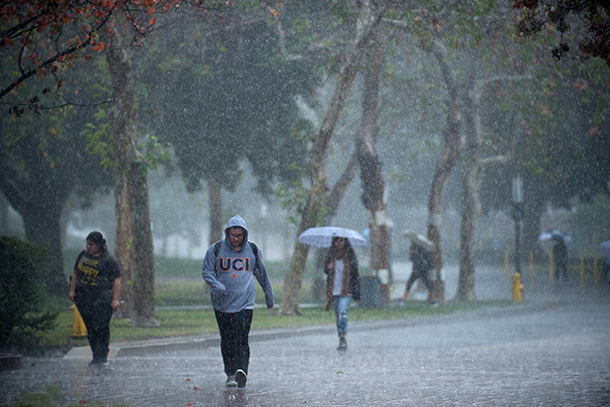
Rain on the campus of UC Irvine (Photo: UC Irvine, CC BY-NC-ND 2.0)
CURWOOD: That's right. You were saying back in April 2014, this is a year and a half ago, a little longer, that we would likely see a fairly intense El Niño phenomena with all this rain going to California, so if in fact there were mechanisms to plan for a lot of rain and capture it, there would be a fair amount of time. You guys are pretty good at predicting this.
TRENBERTH: Well this is one of the things about the science, is that we agree there is much more notice about the likelihood of El Niño occurring and therefore various kinds of activities, not only in California but in other places around the world, are able to change their activities or plan for this or plan for the risk of wildfire in Australia, for instance, in a number of places around the world they actually change the crops they grow, the seeds they plant, the fertilizer strategy, the irrigation strategy, managing hydroelectric power in places that water comes and goes and these kind of events, all of these kinds of things, is the sort of thing that can take advantage of good warnings that these kind of events are under way.
CURWOOD: I really don't want to ask you this question but I have to. When we look at climate distraction, look at global warming, we see that it's on the increase. So if this is the way things are now with the El Niño phenomena, what could we be looking at the planet gets even warmer?
TRENBERTH: In some sense what we're seeing around the world right now is a advanced view of the sort of things that we'll see more off in the future, all of the weather systems being somewhat more vigorous than they have been in the past, the risk of both droughts in some regions and flooding in other regions, and of course, this is very difficult to manage for a farmer - it's much tougher on ecosystems and forests in general. And so these are some of the challenges, but taking lessons from these relatively short-term surges where the mini global warming from El Niño goes along with the global warming from increases in greenhouse gases. Those two things going together is the sort of thing that creates new records and some things begin to break.
CURWOOD: Some things begin to break. What you have in mind?
TRENBERTH: So, scientists say, “well things have gone non-linear”, and so this is where the case in Missouri is a good example. Previously what is the average rainfall there in November and December somewhere around five inches of rain and the previous highest was somewhere around 10 inches of rain, and in this past November, December we're at 15 inches of rain. I mean, there's no reason based on the previous record to expect that, but suddenly we're jumping to a whole new arena and it has consequences and is having big consequences now as it slowly unfolds as the Mississippi River rolls this water downstream.
CURWOOD: How much longer does this El Niño event last do you think?
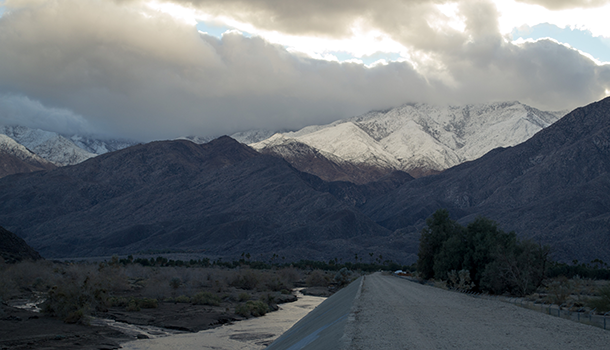
Snow in the San Jacinto mountains in Southern California (Photo: Don Barrett, Flickr CC BY-NC-ND 2.0)
TRENBERTH: Well it looks like this El Niño may have peaked in November in terms of the magnitude of the unusual sea surface temperatures out in the tropical Pacific, and so already it's beginning to fade just a little bit. It's certainly going to be with us through March, but by about April it's expected that this will be fading quite substantially and it'll be basically gone by about June. And so this is the transition, it's the normal time of length of a normal El Niño to last, so exactly how this plays out in the next few months given that it's already beginning to fade a little bit will be interesting to see, but often some of the biggest effects do occur around February across North America.
CURWOOD: So, let's see. Last time we saw ice storms, we saw crazy water in Florida...so I guess we just have to hang on until this is over, huh?
TRENBERTH: This is one of the risks that because conditions are a bit warmer, they are a bit warmer because of the El Niño, that you have vigorous storms coming across the country, but the ground can still be very cold so the risk of an ice storm, a freezing rain storm is a very real one. And this is what happened in 1998 which devastated upper parts of New York state and parts of Canada, for instance, and that is certainly one of the possibilities on the cards.
CURWOOD: Kevin Trenberth is a distinguished senior scientist at the National Center for Atmospheric Research in Boulder, Colorado. Kevin, thank you so much for taking the time today.
TRENBERTH: You’re most welcome.
Links
Kevin Trenberth’s interview predicting a strong El Niño this winter
The impact of El Niño on the California drought
Living on Earth wants to hear from you!
Living on Earth
62 Calef Highway, Suite 212
Lee, NH 03861
Telephone: 617-287-4121
E-mail: comments@loe.org
Newsletter [Click here]
Donate to Living on Earth!
Living on Earth is an independent media program and relies entirely on contributions from listeners and institutions supporting public service. Please donate now to preserve an independent environmental voice.
NewsletterLiving on Earth offers a weekly delivery of the show's rundown to your mailbox. Sign up for our newsletter today!
 Sailors For The Sea: Be the change you want to sea.
Sailors For The Sea: Be the change you want to sea.
 The Grantham Foundation for the Protection of the Environment: Committed to protecting and improving the health of the global environment.
The Grantham Foundation for the Protection of the Environment: Committed to protecting and improving the health of the global environment.
 Contribute to Living on Earth and receive, as our gift to you, an archival print of one of Mark Seth Lender's extraordinary wildlife photographs. Follow the link to see Mark's current collection of photographs.
Contribute to Living on Earth and receive, as our gift to you, an archival print of one of Mark Seth Lender's extraordinary wildlife photographs. Follow the link to see Mark's current collection of photographs.
 Buy a signed copy of Mark Seth Lender's book Smeagull the Seagull & support Living on Earth
Buy a signed copy of Mark Seth Lender's book Smeagull the Seagull & support Living on Earth

